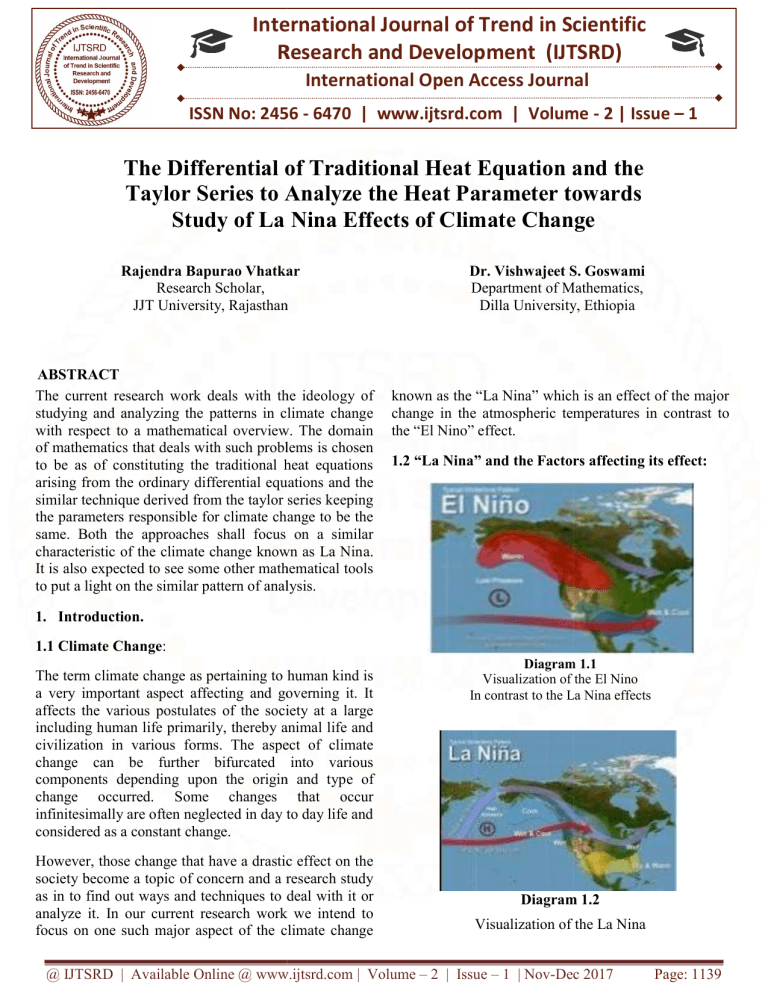
International Journal of Trend in Scientific
Research and Development (IJTSRD)
International Open Access Journal
ISSN No: 2456 - 6470 | www.ijtsrd.com | Volume - 2 | Issue – 1
The Differential oof Traditional Heat Equation and
a the
Taylor Series too Analyze the Heat Parameter towards
owards
Study of La Nina Effects off Climate Change
Rajendra Bapurao Vhatkar
Research Scholar,
JJT University, Rajasthan
ABSTRACT
The current research work deals with the ideology of
studying and analyzing the patterns in climate change
with respect to a mathematical overview. The domain
of mathematics that deals with such problems is chosen
to be as of constituting the traditional heat equations
arising from the ordinary differential equations and the
similar technique derived from the taylor series keeping
the parameters responsible for climate change to be the
same. Both the approaches shall focus on a similar
characteristic of the climate change known as La Nin
Nina.
It is also expected to see some other mathematical tools
to put a light on the similar pattern of analysis.
Dr. Vishwajeet S. Goswami
Department of Mathematics,
Dilla University, Ethiopia
known as the “La Nina” which is an effect of the major
change in the atmospheric temperatures in contrast
co
to
the “El Nino” effect.
1.2 “La Nina” and the Factors affecting its effect:
1. Introduction.
1.1 Climate Change:
The term climate change as pertaining to human kind is
a very important aspect affecting and governing it. It
affects the various postulates of the society at a large
including human life primarily, thereby animal life and
civilization in various forms. The aspect of climate
change can be further bifurcated into various
components depending upon the origin and typ
type of
change occurred. Some changes that occur
infinitesimally are often neglected in day to day life and
considered as a constant change.
However, those change that have a drastic effect on the
society become a topic of concern and a research study
as in too find out ways and techniques to deal with it or
analyze it. In our current research work we intend to
focus on one such major aspect of the climate change
Diagram 1.1
1.
Visualization of the El Nino
In contrast to the La Nina effects
Diagram 1.2
Visualization of the La Nina
@ IJTSRD | Available Online @ www.ijtsrd.com | Volume – 2 | Issue – 1 | Nov-Dec
Dec 2017
Page: 1139
International Journal of Trend in Scientific Research and Development (IJTSRD) ISSN: 2456-6470
As known Earth is continuously in a volatile motion.
This motion is majorly carried out in two forms. The
one below the earth’s surface is studied under the
geology domain. Whereas the studies related to the
atmosphere surrounding the earth is majorly studied
under climatology. Climatology not only studies the
behavior and the anatomy of the particular phenomenon
but also widens the scope of understanding the change
in such patterns which is the result of climate change.
One such climate change effect known as the “La
Nina” effect is our major object of study.
The major phenomenon of La Nina is the reduction of
the oceanic temperature by a few degrees. This effect is
opposite to the “El Nino” which is the aspect of
increase in the ocean temperatures by the considerable
amount of difference as in the case of “La Nina”. The
considerable change in temperatures result in various
other events linked in the similar pattern in the
surroundings. Some of the major factors affecting the
“La Nina” effect is the change in the oceanic wind
temperature and thereby affecting the other two major
parameters known as pressure in atmosphere and
humidity. This in turn gives rise to various other ocean
originated catastrophes like the severe convective
storms, severe thunder storms, storm surge and
hurricanes. These catastrophes then tend to travel and
meet the civilizations on the banks of the coastal line
that cause devastation at a large scale.
1.3 Mathematical Overview:
In the current scenario there are certain mathematical
approaches that deal with the climate change problem
related to El Nina and La Nino. However, we are going
to consider the two basic approaches related to one
parameter affecting this phenomenon. The traditional
heat equation based on the differential expansion and
the Taylor series expansion. As known heat is a
differential entity varying with reference to time and
other certain parameters so it can act as a function of
time and pressure as the certain change in any of the
parameter intends to change the heat parameter.
The expression of heat equation may be given by:
(2.1)
Where q(p) may be considered as the coefficient of the
entity pertaining to the variable heat transfer with
respect to position ‘p’. Whereas on the other part of the
equation
may be considered as the generation
point of heat forming its basis or origin. In case of
climate change the source and the medium may be
considered for the given equation. The further process
of treating this kind of relation is to find the derivative
of the next version that gives scope to understand its
behavior with reference to the boundary values. We
shall also see certain characteristics of the above
relation when it is treated under boundary values to get
the Sturm-Liouville results as a desirable quantity.
Let us first understand the version of the relation (2.1)
as follows. While consideration let us primarily
consider the surrounding of the medium of heat transfer
to follow the propagation in a homogenous pattern.
(2.2)
The above version is due to the differential variation of
the relation (2.1) when we consider q(p) = q which is
independent of p.
This is also the case when the medium is considered to
be homogenous and the entity is expected to change
infinitesimal with respect to the change in its position.
For any equation as it is considered to follow a precise
path of travelling from a particular point to a desired
destination, we shall take into consideration the
boundary value of the domain.
As known in each case of the traditional heat equations,
we shall introduce the boundary values accordingly.
Let us take into consideration the climate change at a
domain level and supposing it to be bounded to assign
the specific values for their boundaries.
2. The traditional Heat equation:
While working with the heat equation the major part of
the problem originated when the heat equation was
studied under a homogenous material. However, when
we consider a non-homogenous domain like the
oceanic atmosphere which has a large amount of gases
that keep changing with respect to time and pressure
behaves a slightly different when considering the
boundary values of these equations. Consider a scenario
of heat function H depending on time t at a position p.
On contrary to the assuming boundary values of the
relation over the domain we take into consideration the
results of Sturm- Liouville conditions that cater the
boundary value for a specific domain for a differential
relation.
The introduction of a linear operator to (2.1) and (2.2)
ahead distributes the variables accordingly, provided
(2.1) is bound to derivate again.
@ IJTSRD | Available Online @ www.ijtsrd.com | Volume – 2 | Issue – 1 | Nov-Dec 2017
Page: 1140
International Journal of Trend in Scientific Research and Development (IJTSRD) ISSN: 2456-6470
Before which to distribute the boundary values over
(2.2) we see the following scenario.
(2.3)
Further derivation shall create the vanishing of the
desired function. This brings closer to the
understanding of the heat equation to be treated in
accordance to conditions satisfying Sturm-Liouville
forms when they are considered under a particular
domain which is separating distinct boundary values
with the aspect of forming a particular track of heat
flow resulting in a climatic change aspect.
3. Taylor Series and the Sturm- Liouville forms:
As per recent literature on similar forms to conduct
analysis of heat transfer due to the climatic condition
the taylor series plays an important role due to its
interdependence of certain variables and the type of
operators involved. Let us consider the variables in the
form of v-velocity, a- humidity, k-temperature.
The following general form may be considered:
excavated onto the other for similar results accordingly.
4. Effect on La Nina and other heat parameters
resulting climate change:
)
The( current
work thereby focuses on the understanding
of the difference of the heat waves when it comes to
study of post effects of climate change due to La Nina.
The modified traditional heat relation comforts an
association with the solutions of the Sturm-Liouville
solvability when treated with the Taylor series.
These assumptions may further give scope to a different
approach to analyze the pattern fitting a particular
condition.
5. Conclusion/Outcome of the research work:
The works that involve the heat transfer over a
continuous medium follows the traditional equation
over the parameters chosen. ( temperature, pressure
and place )
The correlation found among the two cases of the
traditional relation and the taylor series gives scope
to further development of analysis on the climate
change aspect.
There are other aspects of El Nino to be further
treated for the similar causes that can act on the
contrary to La Nina.
REFERENCES:
(3.1)
For one entity to be fixed the other parameters move
or differentiate infinitesimally with respect to the
variable entity. In any case the function tends to vary
with a precise change in one of the three entities and
keeping one entity constant.
(3.2)
and so on.
We may consider to formulate the linear operator in
lieu of the slope of the curve formed by the release of
variation in the temperature.
Finally to formulate the relation of the Sturm-Liouville
solvability we see the approximate relation as below
when the boundary values are taken into consideration.
(3.3)
1. Bhupendra Nath Tiwari (2017), A Mathematical
Modeling of Climate Changing via El Nino and La
Nina Effects. International Scientific Conference
GEOBALCANICA 2017.
2. Environmental Protection Agency. Climate change.
2010. Available at: www.epa. gov/climatechange.
Accessed February 9, 2016.
3. Timmermann, Axel, et al., Increased El Niño
frequency in a climate model forced by future
greenhouse warming, Nature 398, 6729, 694-697,
1999.
4. J. Parikh, ‘Gender and Climate change: Framework
for Analysis, Policy and Action’, www.undp.org.,
2008
5. iPCC, ‘Fourth Assessment Report – Synthesis
Report’, WMO and uneP, 2007.
(3.3)
There are various further possible works that may put
light on the interpolation of these theories to be
@ IJTSRD | Available Online @ www.ijtsrd.com | Volume – 2 | Issue – 1 | Nov-Dec 2017
Page: 1141





